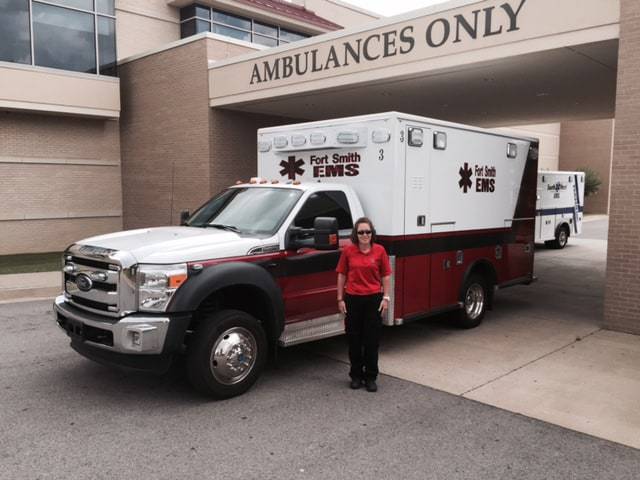First Three Graduate UAMS’ EMS Bachelor’s Degree Program
| July 20, 2015 | Fort Smith paramedic Miranda Hagans says the opportunity to further her education led to pursuing a bachelor’s degree in Emergency Medical Sciences at UAMS.
After recently becoming one of the first three graduates of the degree program in the College of Health Professions program, she now sees how the additional skills will allow her to better serve her community. The college started the program, the first of its kind in Arkansas and one of the few in the nation, in 2013 with a goal of enhancing the leadership and problem-solving skills of experienced EMS professionals.

Fort Smith paramedic Miranda Hagans was one of the first graduates of the bachelor’s degree program in emergency medical sciences at UAMS.
“Miranda exemplifies why we added the degree program — a way to strengthen leadership skills and make an experienced paramedic even more valuable to the community they serve,” said Danny Bercher, Ph.D., chair of the college’s Department of Emergency Sciences. “Our focus has been about EMS (emergency medical services) leadership and equipping the bachelor’s degree graduate with the tools to evaluate and improve EMS systems and the communities they serve.”Hagans has been working in emergency medical services for 13 years, the last seven as a paramedic. She now works as a paramedic for four area agencies including Fort Smith EMS, the University of Arkansas at Fort Smith (where she also is an EMS Instructor), the U.S. Department of Energy and Sebastian County EMS.
“I had always wanted to further my education but there were fewer options after the associate’s degree,” she said. “I really have a deep passion for EMS and seeking the latest information available. I want to be part of moving emergency medical services forward as health care changes.
“I also saw this as a way to be able to pass on the newest techniques and innovations to colleagues and students.”
She points to a three-month trip earlier this year to Pacific island territory Guam. There she taught EMS updates to local emergency medical technicians (EMTs), advanced EMTs, and U.S. Air Force Paramedics. She worked with the U.S. military, Department of Homeland Security, Guam government and local groups to assist them in bringing their EMS system up to national standards.
“That was the kind of career opportunity I would never have though possible before, using my education to help improve the EMS system overall including military and local EMS services,” Hagans said.
The degree positions the graduate at the forefront of emerging trends in the profession, Bercher said. He mentioned the aspect of community paramedic with the EMS professionals taking on a more preventative health care role, complementing with work of community health professionals, providing follow up with patients discharged from hospitals and other types of patient education.
As part of the degree coursework, Hagans spent time in rural north Arkansas with the Baxter County Community Paramedic program, the first such program in the state. The UAMS EMS faculty provided the education for Baxter County paramedics who established the program in 2013.
Hagans worked with the program’s staff and coordinated with area home health professionals who provided in-home primary care in the largely rural area.
“As paramedics, we are already accustomed to treating patients in their homes, so this concept allows us to extend our scope into preventative health care and improve the health outcomes in our communities and reducing the cost of health care,” Hagans said.
Also during her coursework, Hagans then drafted a proposal for creating a community paramedic program in Fort Smith. It was approved and is now in development for what she hopes will be the second working community paramedic program in the state.